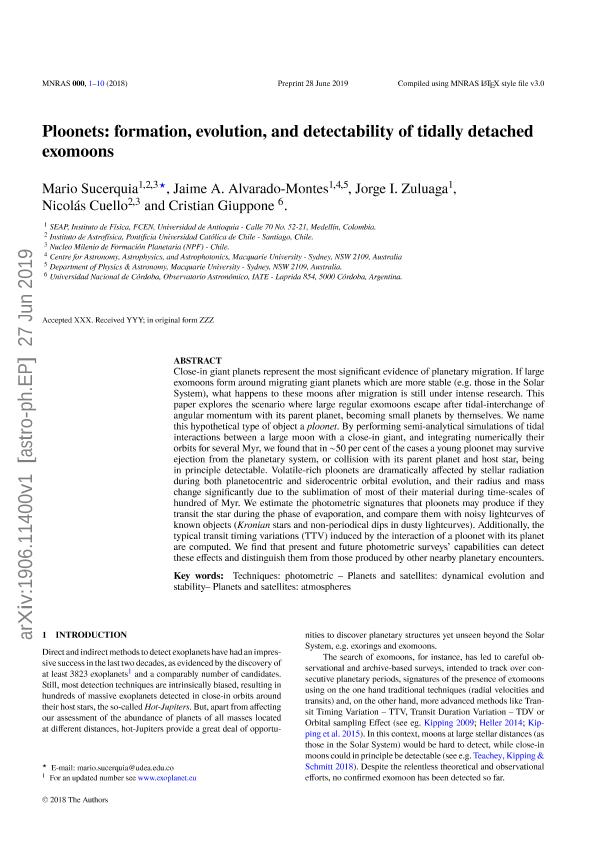Mostrar el registro sencillo del ítem
dc.contributor.author
Sucerquia, Mario
dc.contributor.author
Alvarado-Montes, Jaime A.
dc.contributor.author
Zuluaga, Jorge I.
dc.contributor.author
Cuello, Nicolas

dc.contributor.author
Giuppone, Cristian Andrés

dc.date.available
2020-12-18T15:59:06Z
dc.date.issued
2019-07
dc.identifier.citation
Sucerquia, Mario; Alvarado-Montes, Jaime A.; Zuluaga, Jorge I.; Cuello, Nicolas; Giuppone, Cristian Andrés; Ploonets: Formation, evolution, and detectability of tidally detached exomoons; Wiley Blackwell Publishing, Inc; Monthly Notices of the Royal Astronomical Society; 489; 2; 7-2019; 2313-2322
dc.identifier.issn
0035-8711
dc.identifier.uri
http://hdl.handle.net/11336/120850
dc.description.abstract
Close-in giant planets represent the most significant evidence of planetary migration. If large exomoons form around migrating giant planets which are more stable (e.g. those in the Solar system), what happens to these moons after migration is still under intense research. This paper explores the scenario where large regular exomoons escape after tidal interchange of angular momentum with its parent planet, becoming small planets by themselves. We name this hypothetical type of object a ploonet. By performing semi-analytical simulations of tidal interactions between a large moon with a close-in giant, and integrating numerically their orbits for several Myr, we found that in ∼50 per cent of the cases a young ploonet may survive ejection from the planetary system, or collision with its parent planet and host star, being in principle detectable. Volatile-rich ploonets are dramatically affected by stellar radiation during both planetocentric and siderocentric orbital evolution, and their radius and mass change significantly due to the sublimation of most of their material during time-scales of hundreds of Myr. We estimate the photometric signatures that ploonets may produce if they transit the star during the phase of evaporation, and compare them with noisy light curves of known objects (Kronian stars and non-periodical dips in dusty light curves). Additionally, the typical transit timing variations (TTV) induced by the interaction of a ploonet with its planet are computed. We find that present and future photometric surveys' capabilities can detect these effects and distinguish them from those produced by other nearby planetary encounters.
dc.format
application/pdf
dc.language.iso
eng
dc.publisher
Wiley Blackwell Publishing, Inc

dc.rights
info:eu-repo/semantics/openAccess
dc.rights.uri
https://creativecommons.org/licenses/by-nc-sa/2.5/ar/
dc.subject
PLANETS AND SATELLITES: ATMOSPHERES
dc.subject
PLANETS AND SATELLITES: DYNAMICAL EVOLUTION AND STABILITY
dc.subject
TECHNIQUES: PHOTOMETRIC
dc.subject.classification
Astronomía

dc.subject.classification
Ciencias Físicas

dc.subject.classification
CIENCIAS NATURALES Y EXACTAS

dc.title
Ploonets: Formation, evolution, and detectability of tidally detached exomoons
dc.type
info:eu-repo/semantics/article
dc.type
info:ar-repo/semantics/artículo
dc.type
info:eu-repo/semantics/publishedVersion
dc.date.updated
2020-11-19T21:24:15Z
dc.identifier.eissn
1365-2966
dc.journal.volume
489
dc.journal.number
2
dc.journal.pagination
2313-2322
dc.journal.pais
Reino Unido

dc.journal.ciudad
Londres
dc.description.fil
Fil: Sucerquia, Mario. Universidad de Antioquia. Facultad de Física; Colombia. Pontificia Universidad Católica de Chile; Chile
dc.description.fil
Fil: Alvarado-Montes, Jaime A.. Macquarie University. Faculty Of Science And Engineering. Department Of Earth And Planetary Sciences.; Australia. Universidad de Antioquia. Facultad de Física; Colombia
dc.description.fil
Fil: Zuluaga, Jorge I.. Universidad de Antioquia; Colombia
dc.description.fil
Fil: Cuello, Nicolas. Pontificia Universidad Católica de Chile; Chile. Universidad de Buenos Aires. Facultad de Ciencias Sociales. Instituto de Investigaciones "Gino Germani"; Argentina
dc.description.fil
Fil: Giuppone, Cristian Andrés. Universidad Nacional de Córdoba. Observatorio Astronómico de Córdoba; Argentina. Consejo Nacional de Investigaciones Científicas y Técnicas. Centro Científico Tecnológico Conicet - Córdoba. Instituto de Astronomía Teórica y Experimental. Universidad Nacional de Córdoba. Observatorio Astronómico de Córdoba. Instituto de Astronomía Teórica y Experimental; Argentina
dc.journal.title
Monthly Notices of the Royal Astronomical Society

dc.relation.alternativeid
info:eu-repo/semantics/altIdentifier/url/https://arxiv.org/abs/1906.11400
dc.relation.alternativeid
info:eu-repo/semantics/altIdentifier/doi/http://dx.doi.org/10.1093/mnras/stz2110
Archivos asociados
